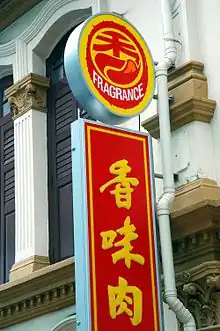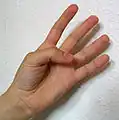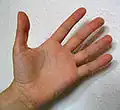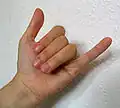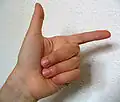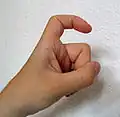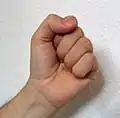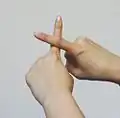Chinese phrasebook
language group of the Sinitic languages
Mandarin Chinese is the official language of mainland China, and one of the official languages of Taiwan and Singapore. Chinese is also one of the official languages in Hong Kong and Macau, although most local people speak Cantonese instead of Mandarin. In English, it is often just called "Mandarin" or "Chinese". While not an official language, it is also widely studied and spoken by the Chinese minorities in Malaysia, Brunei and Myanmar, and commonly heard in Chinatowns throughout the world. In China, it is called Pǔtōnghuà (普通话), meaning "common speech", while in Taiwan it is referred to as Guóyǔ (國語), "the national language." In Indonesia, it is widely known as Zhōnghuáyǔ (中华语), and in Singapore and Malaysia, it simply referred to as Huáyǔ (华语). It has been the main language of education in mainland China and Taiwan since the 1950s, so most non-elderly locals speak it regardless of what their native language or dialect is.
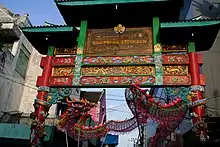
- This article is about Standard Mandarin Chinese. For Cantonese Chinese (official language in Hong Kong and Macau), see Cantonese phrasebook
- Phrasebooks for other varieties of Chinese are listed at China#Talk.
While the spoken Mandarin in the above places is more or less the same, the written characters are different. Taiwan, Hong Kong and Macau all still use traditional characters, whereas Mainland China and Singapore use a simplified derivative. In Indonesia, the older Chinese generations tend to use the traditional characters, but younger generations tend to use the simplified one, though most of the time, the usage of Latin script is way more commonly practiced.
Understand
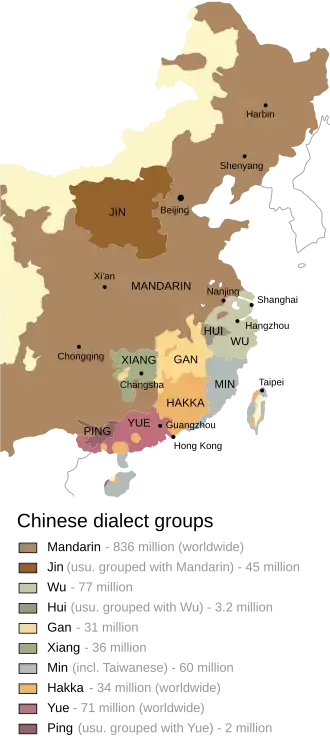
China is host to a wide variety of related languages (often referred to as dialects), of which Standard Mandarin is just one. Within the Chinese language family, there are 7-10 major branches, each of which contain their own varieties of languages. Languages from different branches (such as Mandarin and Cantonese) are completely mutually unintelligible, whereas languages within the same branch (such as Standard Mandarin and Sichuanese) may have limited mutual intelligibility.
Despite the wide variance in Chinese languages, all speakers normally write the same standard form (using either traditional or simplified characters). This is possible because the Chinese writing system is logographic, meaning individual characters represent ideas as opposed to phonetic sounds. What this means is that one character that would be pronounced completely differently in any number of Chinese languages will be written identically and understood to mean the same thing. Therefore speakers of different Chinese languages who are completely unable to understand each others' speech can effectively communicate via writing. The challenge with a logographic writing system, however, is the huge number of characters required to adequately represent different words: the average Chinese dictionary indexes around 20,000 characters, with an educated Chinese person likely knowing around 8,000, while a typical newspaper requires the reader to know at least 3,000 characters.
|
A (related) tale from Chinese Wikipedia
In the early days of Chinese Wikipedia, radical supporters of both traditional and simplified Chinese characters vandalized the site by converting the opposing writing system into their favored one. The problem was essentially resolved by creating an automatic translator that converts between traditional and Chinese characters (including vocabulary differences between multiple regions), allowing users to read and edit an article in whichever variety they wish. It's not a perfect system, as there are about 100 characters that don't have a one-to-one mapping, and tens of thousands of words that need to be translated differently depending on context. And there are still issues that can't be fixed with software, such as writing from a neutral global point of view. But it broadly succeeded at solving the vandalism problem, consolidated Chinese Wikipedia into a single version rather than separate ones for China and Taiwan, and paved the way for automatic translators for other languages that can be written in multiple scripts. |
Following the establishment of the People's Republic of China (PRC), formal simplifications were made to a large number of common characters in order to reduce the number of strokes required to write them, with the aim of increasing literacy. This has led to two current standards for Chinese writing: Simplified and Traditional characters. Simplified characters are the standard for Singapore and mainland China, whereas Traditional characters are retained as the standard in Hong Kong, Macau, and Taiwan. The use of traditional or simplified characters can have controversial political connotations, particularly in Hong Kong. Traditional characters are generally preferred in calligraphy, even in mainland China, due to their superior aesthetic value.
About one fifth of the world's population speak some form of Chinese as their native language. It is a tonal language that is related to Burmese and Tibetan. In addition, the Dungan language, which is spoken in some parts of the former Soviet Union, is considered to be a variant of Mandarin but uses the Cyrillic alphabet instead of Chinese characters.
The writing system is used by other countries as well, although the languages are not related. The Korean writing system historically used Chinese characters, but completely abandoned them in favor of their own 'Hangul' system since the 1950s. South Koreans still learn the basics of Chinese characters, and some basic Chinese characters are still occasionally used and widely understood; Japanese uses a mixed writing system comprising of Chinese characters and its own 'kana' system, although over time the meaning of some characters has diverged significantly from those used in Chinese: see this Wiktionary page for a list of similar words with different meanings in Chinese and Japanese language. The Vietnamese language (which uses a distinctive version of the Latin alphabet) has borrowed many words from Chinese, and prior to the French colonisation used Chinese and Chinese-like characters as well.
Standard Mandarin is based on the Mandarin dialect of the Beijing area, and is almost universally understood and spoken (in conjunction with local languages) across mainland China and Taiwan as a result of being the primary language of education and the media. Travelers headed to the special administrative regions (SARs) of Hong Kong or Macau will largely encounter native Cantonese speakers. Mandarin is largely understood in the SARs, though speaking ability varies widely, and in Hong Kong, the use of Mandarin is a touchy political issue. Those heading for Taiwan or South Fujian may find the Minnan dialect useful as well.
Difficulties
In the West, Chinese has a reputation for difficulty. In fact, its difficulty to learn once led to calls to replace Chinese characters and grammar with Latin script and English grammar during the 1920s by some intellectuals and writers. These opinions eventually died out, but they certainly influenced the ruling communist party's policy on simplified Chinese characters.
The language is more dense than European languages, meaning considerably more can be said in a text message with the same number of characters. Each character corresponds to a syllable, and each syllable can have multiple meanings depending on the tone with which it is pronounced. Compared to, say, Japanese or Korean, Chinese contains many fewer loan words from European languages such as English, meaning that more effort will have to be made to acquire vocabulary. The grammar, however, may strike a Westerner as pretty simple. Verbs and adjectives are static regardless of subject and whether they are referring to the past, present or future. Nouns do not have genders like most European languages, and there is no separate form for plurals. The main difficulties are the five tones, numerous consonants that are not found in European languages, and the numerous characters.
Mandarin, like Vietnamese and Thai, is a tonal language that uses different pitches in syllables and words to indicate different meanings. "Ma" could mean mother, horse, numb, or blame, depending on the tone. Homophones are also common; the same sound at the same pitch can have dozens of meanings. "Zhōng" ("Zhong" with the 1st tone) can mean China/central/centre (中), loyalty (忠), clock (钟), chime (钟), finish (终), a bowl (盅), etc. All of them come with different Chinese characters, just the same sound at the same pitch. While homophones are rarely a problem in most everyday conversations, it is common for Chinese to ask how to write someone's name by identifying the characters one by one. "My name is Wang Fei (王菲). Wang is the "wang" with four strokes, Fei is the "fei" in "shifei" (gossip), with a grass on top."
Written Chinese looks like a mysterious secret code to some, but if you can recognize so many commercial logos (usually not logically related), you will be impressed with your capacity to memorize so many characters - most of which are logically related and formed based on certain rules.
There are, in theory, more than 50,000 Chinese characters. The good news is that more than 85% have become obsolete, or are rarely used. Like native speakers of many languages, most Chinese couldn't tell you how many characters are required to read a book and never bother to count how many characters they know. One may argue that junior students are supposed to learn at least 2000 characters and university graduates 5000 characters.
Pronunciation guide

To bridge the gap between recognizing characters and reading out loud, Hanyu pinyin was developed, which uses Latin script as an aid to teaching Chinese. Pronouncing pinyin is not intuitive as certain letters and consonant clusters are used to represent sounds not present in European languages and are thus not pronounced as an English speaker would expect. Nonetheless, learning pinyin at even a basic level has enormous practical value for the traveller. Written pinyin is less useful as most Chinese will not recognize place names or addresses in pinyin, and the same pinyin can be shared by different Chinese characters; it is always better to use characters for written communication.
The pronunciation guide below uses Hanyu pinyin, which is the official romanization of the People's Republic of China and Taiwan. Mainland China uses Hanyu pinyin almost universally, though a few older transliterations remain in names like Tsingtao Beer and Peking University. Taiwan used to use the Wade-Giles system, which is quite different, then in 2002 switched to Tongyong pinyin, only slightly different from Hanyu pinyin, and since 2009 uses Hanyu pinyin just like the People's Republic. However, many older transliterations remain in use in Taiwan, and you may well encounter multiple spellings of the same name (like Tamsui, Tamshui, and Danshui for the town in New Taipei).
Pinyin allows very accurate pronunciation of Mandarin for those who understand it, although the way that it uses letters like q, x, c, z and even i is not at all intuitive to the English speaker since some of these sounds do not exist in English or many other languages. Thus, studying the pronunciation guide below carefully is essential. After you master the pronunciation you will need to move on to the next challenge: using accurate tones whilst speaking.
Some pinyin vowels (especially "e", "i", "ü") can be tricky, so it is best to get a native speaker to demonstrate. Also, beware of the spelling rules listed in the exceptions below.
- a
- as in father; otherwise
- a in ian and yan
- as "e" in "bet" or "text" (just the English short "e" sound)
- e
- unrounded back vowel (IPA [ɤ]), similar to duh; in unstressed syllables, a schwa (IPA [ə]), like idea
- i
- as in see or key;
after ch, sh, zh, c, s, z or r, not really a vowel at all but just a stretched-out consonant sound - o
- as in more
after b, p, m, or f, as in war - u
- as in soon; but read ü in ju, qu, yu and xu
- ü
- as in French lune or German grün; pronounced like "ee" but with rounded lips
Vowel combinations
These are the most important vowel combinations in Chinese:
- ai
- as in pie
- ao
- as in pouch
- ei
- as in pay
- ia
- as in ya
- ia in ian (but not iang)
- as in 'yes
- iao
- as in meow
- ie
- as in yes
- iong
- as in Pyongyang
- iu
- as in yodel
- ou
- as in mow
- ua
- as in want
- uo
- as in war
Consonants
Chinese stops distinguish between aspirated and unaspirated, not unvoiced and voiced as in English, and Chinese lacks voiced stops. Aspirated sounds are pronounced with a distinctive puff of air as they are pronounced in English when at the beginning of a word, while unaspirated sounds are pronounced without the puff, as in English when found in clusters.
Place a hand in front of your mouth and compare pit (aspirated) with spit (unaspirated) to see the difference. Note that the list below only gives approximate pronunciations, as many of these consonants have no equivalent in English. As Mandarin does not have voiced stops or affricates, all the consonants listed in the "unaspirated" column should be pronounced unvoiced.
| Unaspirated | Aspirated | ||
|---|---|---|---|
| b | as in spot | p | as in pit |
| d | as in stop | t | as in tongue |
| g | as in skin | k | as in king |
| j | as in itchy | q | as in cheap |
| zh | as in jungle | ch | as in chore |
| z | as in pizza | c | as in rats |
Here are the other consonants in Chinese:
- m
- as in mow
- f
- as in fun
- n
- as in none or none
- l
- as in lease
- h
- a throaty h sound as in Scottish loch/Spanish jefe (IPA: [x])
- x
- as in sheep, but softer than sh
- sh
- as in shoot
- r
- as in fair
- s
- as in sag
- ng
- as in sing
- w
- as in wing but silent in wu. Before a, ai, ang, eng, and/or o
- y
- as in yet but silent in yi, yu
If you think that is a fairly intimidating repertoire, rest assured that many Chinese people, particularly those who are not native Mandarin speakers, will merge many of the sounds above (especially c with ch and z with zh). Other sounds that you may hear merged, depending on the region, include s with sh, f with h, l with n, l with r, i with ü, and n with ng. These are particularly common in southern China, Taiwan and overseas Chinese communities.
Exceptions
There are a fairly large number of niggling exceptions to the basic rules above, based on the position of the sound:
- wu-
- as u-, so 五百 (五百) wubai is pronounced "ubai"
- yi-
- as i-, so 一个 (一個) yige is pronounced "ige"
- yu-
- as ü-, so 豫园 (豫園) Yuyuan is pronounced "ü-üan"
Tones
|
How do I put my tone marks?
If you are confused by how to put tone marks above the Hanyu Pinyin, follow the steps below: Always insert tone marks above the vowels. If there is more than one vowel letter, follow the steps below: (1) Insert it above the 'a' if that letter is present. For example, it is rǎo and not raǒ (2) If not, insert it above 'o'. For example, guó and not gúo (3) Insert it above the letter 'e' if the letters 'a' and 'o' are not present. For example, jué and not júe (4) If only 'i', 'u' and 'ü' are the only present letters, insert it in the letter that occurs last. For example, jiù and not jìu, chuí and not chúi. Note, if the vowel present is ü, the tone mark is put in addition to the umlaut. For example, lǜ |
There are five tones in Mandarin that must be followed for proper pronunciation. Never underestimate the importance of these tones. Consider a vowel with a different tone as simply a different vowel altogether, and you will realize why Chinese will not understand you if you use the wrong tone — mǎ is to mā as "I want a cake" is to "I want a coke". Be especially wary of questions that have a falling tone, or conversely exclamations that have an "asking" tone (eg jǐngchá, police). In other words, pronounced like does not imply meaning. While Mandarin speakers also vary their tone just like English speakers do to differentiate a statement from a question and convey emotion, it is much more subtle. Do not try it until you have mastered the basic tones.
- 1. first tone ( ā )
- "high tone": flat, high pitch that is more sung instead of spoken.
- 2. second tone ( á )
- "rising tone": low to middle, rising pitch that is pronounced like the end of a question phrase (Whát?).
- 3. third tone ( ǎ )
- "low tone" or "falling-rising": mid-low to low. For two consecutive syllables in the third tone, the first syllable is pronounced as if it is in the second tone. For example, 打扰 dǎrǎo is pronounced as dárǎo. (When stressed, the third tone is sometimes pronounced mid-low to low to high, dipping pitch.)
- 4. fourth tone ( à )
- "falling tone": high to low, rapidly falling pitch that is pronounced like a command (Stop!).
- 5. neutral tone ( a )
- "toneless": short, unstressed syllable; rarely used by itself (except for phrase particles) but frequently occurs as the second part of a phrase.
Regional differences
While standard Mandarin in mainland China, Taiwan and Hong Kong/Macau is fundamentally similar, and speakers from these regions can generally communicate with each other with no major issues, there are several terms which differ. These differences mainly stem from stronger influences from southern Chinese dialects and Japanese in Taiwanese Mandarin, as well as differing translations for some post-1949 modern concepts.
These differences are generally understandable to Chinese speakers from different places, if not serving as a hint of the speaker's background. Some Taiwanese and Hongkongers shun mainland Chinese words and view them as attempts at cultural assimilation. This is particularly true for translations in arts and entertainment.
The following is a list of some common terms that differ among different areas.
| English | Mainland China | Taiwan | Hong Kong | Macau | Singapore | Indonesia | Notes |
|---|---|---|---|---|---|---|---|
| taxi | 出租车 (出租車) chū zū chē | 计程车 (計程車) jì chéng chē | 的士 (的士) | 的士 (的士) | 德士 (德士) dé shì | 捡起车 jiǎn qǐ chē | |
| metro / subway | 地铁 (地鐵) dì tiě | 捷运 (捷運) jié yùn | 地铁/港铁 (地鐵/港鐵) | 地铁 (地鐵) | 地铁 (地鐵) dì tiě | 港铁 (港鐵) unambiguously refers to Hong Kong's Mass Transit Railway. | |
| light rail | 轻轨 (輕軌) qīng guǐ | 轻轨 (輕軌) qīng guǐ | 轻铁 (輕鐵) | 轻轨 (輕軌) | 轻轨 (輕軌) qīng guǐ | ||
| bicycle | 自行车 (自行車) zì xíng chē | 脚踏车 (腳踏車) jiǎo tà chē | 单车 (單車) | 单车 (單車) | 脚踏车 (腳踏車) jiǎo tà chē / 脚车 (腳車) jiǎo chē | 桨车 jiăng chē | |
| air conditioning | 空调 (空調) kōng tiáo | 冷气 (冷氣) lěng qì | 冷气 (冷氣) | 冷气 (冷氣) | 冷气 (冷氣) lěng qì | 空温 kōng wēn | |
| potato | 土豆 (土豆) tǔ dòu | 马铃薯 (馬鈴薯) mǎ líng shǔ | 薯仔 (薯仔) | 薯仔 (薯仔) | 马铃薯 (馬鈴薯) mǎ líng shǔ | 荷兰红薯 hé lán hóng shǔ | 土豆 (土豆) refers to peanuts in Taiwan |
| pineapple | 菠萝 (菠蘿) bō luó | 凤梨 (鳳梨) fèng lí | 菠萝 (菠蘿) | 菠萝 (菠蘿) | 黄梨 (黃梨) huáng lí | ||
| boxed meal | 盒饭 (盒飯) hé fàn | 便当 (便當) biàn dāng | 饭盒 (飯盒) | 饭盒 (飯盒) | 便当 (便當) biàn dāng / 饭盒 (飯盒) fàn hé | 便当盒 biàn dang hé | |
| text message / SMS | 短信 (短信) duǎn xìn | 简讯 (簡訊) jiǎn xùn | 短讯 (短訊) | 短讯 (短訊) | 简讯 (簡訊) jiǎn xùn | ||
| spoon | 勺子 (勺子) sháo zi | 汤匙 (湯匙) tāng chí | 匙羹 (匙羹) chí gēng | 匙羹 (匙羹) | 汤匙 (湯匙) tāng chí | 勺 sháo |
Also note that while the term 小姐 (小姐) xiǎo jiě is often used to address young women and waitresses in Taiwan (and in Singapore and Malaysia), it is a euphemism for "prostitute" in mainland China, and thus would be considered an insult. In mainland China, the corresponding word for addressing a young woman would be 女士 (女士) nǚ shì (which can be used for women of all ages), while the word for addressing a waitress would be 服务员 (服務員) fú wù yuán (which is used for waitstaff of both sexes).
Another term that can cause confusion is 冲凉 (沖涼) chōng liáng, which means "to take a cold shower" in China, but refers to taking any kind of shower in Malaysia and Singapore. Similarly 做工 (做工) zuò gōng means "to work", but it refers specifically to doing manual labour in mainland China and Taiwan, while it refers to doing any kind of work in Malaysia and Singapore.
The Chinese names for several countries and locations also differ between Mainland China and Taiwan, as shown in the table below. Hong Kong uses a blend of Mainland Chinese and Taiwanese names, plus indigenous place names (especially for UK place names) derived from Cantonese.
| Country/Location | Mainland China | Taiwan | Hong Kong | notes |
|---|---|---|---|---|
| Australia | 澳大利亚 (澳大利亞) Ào dà lì yà | 澳洲 (澳洲) Ào zhōu | 澳洲 (澳洲) | |
| Bangladesh | 孟加拉国 (孟加拉國) Mèng jiā lā Guó | 孟加拉 (孟加拉) Mèng jiā lā | 孟加拉 (孟加拉) | In Mainland China, 孟加拉 (孟加拉) refers to the entire Bengal region covering Bangladesh and the Indian state of West Bengal. In Hong Kong may also be a slang for idiot/fool, depending on the context. |
| Georgia (European country) | 格鲁吉亚 (格魯吉亞) Gé lǔ jí yà | 乔治亚 (喬治亞) Qiáo zhì yà | 格鲁吉亚 (格魯吉亞) | |
| Laos | 老挝 (老撾) Lǎo wō | 寮国 (寮國) Liáo guó | 老挝 (老撾) | |
| New Zealand | 新西兰 (新西蘭) Xīn xī lán | 纽西兰 (紐西蘭) Niǔ xī lán | 新西兰 (新西蘭) | |
| North Korea | (北)朝鲜 ((北)朝鮮) Cháo xiǎn | 北韩 (北韓) Běi hán | 北韩 (北韓) | The Korean peninsula is always referred as 朝鲜半岛 (朝鮮半島) regardless of location, except in South Korean official statements where it is referred as 韩半岛 (韓半島). |
| Qatar | 卡塔尔 (卡塔爾) Kǎ tǎ 'ěr | 卡达 (卡達) Kǎ dá | 卡塔尔 (卡塔爾) | |
| Saudi Arabia | 沙特 (沙特) Shā tè | 沙乌地 (沙烏地) Shā wū dì | 沙特阿拉伯 (沙特阿拉伯) | |
| South Korea | 韩国 (韓國) Hán guó | 南韩 (南韓) Nán hán | 南韩/韩国 (南韓/韓國) | In Taiwan and sometimes in Hong Kong, 韩国 (韓國) refers to the entire Korea before its division. |
| Georgia, United States | 佐治亚 (佐治亞) Zuǒ zhì yà | 乔治亚(州) (喬治亞(州)) Qiáo zhì yà (zhōu) | 佐治亚 (佐治亞) | To prevent confusion, the suffix "州" (state) may be added to distinguish the American state with the European country. |
| Virginia, United States | 弗吉尼亚 (弗吉尼亞) Fú jí ní yà | 维吉尼亚 (維吉尼亞) Wéi jí ní yà | 维珍尼亚 (維珍尼亞) | |
| British Columbia, Canada | 不列颠哥伦比亚 (不列顛哥倫比亞) Bù liè diān Gē lún bǐ yà | 英属哥伦比亚 (英屬哥倫比亞) Yīng shǔ Gē lún bǐ yà | 卑诗 (卑詩) | 卑诗 (卑詩) is the local name used by Chinese communities in BC. |
| Aberdeen, United Kingdom | 阿伯丁 Ā bó dīng | 亚伯丁 (亞伯丁) Yà bó dīng | 鸭巴甸 (鴨巴甸) |
Phrase list
All phrases show both the simplified characters (used in mainland China, Singapore, and Indonesia) and the traditional characters (used in Taiwan, Hong Kong, and Macau) in the following format:
- English phrase
- Simplified characters (Traditional characters) Hanyu Pinyin
Basics
|
Pronouns
Chinese pronouns are relatively straightforward.
|
|
Have you eaten?
The literal translation of "how are you", Nǐ hǎo ma?, will be understood but may sound stilted and foreign. When greeting someone, it's more natural to ask some variation of 你吃饭了吗? (你吃飯了嗎) Nǐ chī fàn le ma? (Have you eaten?). You can answer like this:
|
- Hello.
- 你好。 (你好。) Nǐ hǎo.
- Hello. (only on the telephone)
- 喂。 (喂。) Wéi. (In Malaysia and Singapore, the English "hello" is typically used instead)
- How are you?
- 你好吗? (你好嗎?) Nǐ hǎo ma? (In Indonesia, it is often shortened as Nǐ hăo?)
- Not bad
- 还不错。 (還不錯。) Hái búcuò.
- Fine, thank you.
- 很好, 谢谢。 (很好,謝謝。) Hěn hǎo, xièxie.
- May I please ask, what is your name?
- 请问你叫什么名字? (請問你叫什麼名字?) Qǐngwèn nǐjiào shěnme míngzì?
- What is your name?
- 你叫什么名字? (你叫什麼名字?) Nǐ jiào shénme míngzì?
- My name is ______ .
- 我叫 _____ 。 (我叫 _____ 。) Wǒ jiào ______ .
- Nice to meet you.
- 很高兴认识你。 (很高興認識你。) Hěn gāoxìng rènshi nǐ. / 幸会。 (幸會。) Xìng huì.
- Please.
- 请。 (請。) Qǐng.
- Thank you.
- 谢谢。 (謝謝。) Xièxie.
- You're welcome.
- 不客气。 (不客氣。) Bú kèqi.
- Excuse me. (getting attention)
- 请问。 (請問。) qǐng wèn.
- Excuse me. (begging pardon)
- 打扰一下。 (打擾一下。) Dǎrǎo yixià / 麻烦您一下。 (麻煩您一下。) Máfan nín yíxià.
- Excuse me. (coming through)
- 对不起。 (對不起。) ‘’Duìbùqǐ’’ / 请让一下。 (請讓一下。) Qǐng ràng yixià
- I'm sorry.
- 对不起。 (對不起。) Duìbuqǐ.
- It's okay. (polite response to "I'm sorry")
- 没关系。 (沒關系。) méiguānxi.
- Goodbye
- 再见。 (再見。) Zàijiàn
- Goodbye (informal)
- 拜拜。 (拜拜。) Bai-bai (Byebye) (In Indonesia, the more common phrase is Dà-dà)
- I can't speak Chinese.
- 我不会说汉语。 (我不會說漢語。) Wǒ bú huì shuō hànyǔ.
- Do you speak English?
- 你会说英语吗? (你會說英語嗎?) Nǐ huì shuō Yīngyǔ ma?
- Is there someone here who speaks English?
- 这里有人会说英语吗? (這裏有人會說英語嗎?) Zhèlĭ yǒu rén hùi shuō Yīngyǔ ma?
- Help! (in emergencies)
- 救命! (救命!) Jiùmìng!
- Good morning.
- 早安。 (早安。) Zǎo'ān.
- Good evening.
- 晚上好。 (晚上好。) Wǎnshàng hǎo.
- Good night.
- 晚安。 (晚安。) Wǎn'ān.
- I don't understand.
- 我听不懂。 (我聽不懂。) Wǒ tīng bu dǒng. (when listening) / 我看不懂。 (我看不懂。) Wǒ kàn bu dǒng. (when reading) (In Indonesia, the more common phrase is 我不知道 Wǒ bù zhī dào)
- Where is the toilet?
- 厕所在哪里? (廁所在哪裡?) Cèsuǒ zài nǎlǐ?
- Where is the bathroom(polite)?
- 洗手间在哪里? (洗手間在哪裡?) Xǐshǒujiān zài nǎlǐ?
- How do you say ____?
- ____ 怎么说? (____ 怎麼說?) ____ zěnme shuō?
Problems
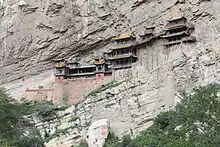
|
To be or not to be?
Chinese does not have words for "yes" and "no" as such; instead, questions are typically answered by repeating the verb. Here are common examples:
If all this seems like too much to handle, you can say "yes" with a short falling-tone grunt (嗯 ǹg), and you'll usually be understood if you say 不 bù for "no". |
- Leave me alone.
- 不要打扰我。 (不要打擾我。) búyào dǎrǎo wǒ
- I don't want it! (useful for people who come up trying to sell you something)
- 我不要! (我不要!) wǒ búyào!
- Don't touch me!
- 不要碰我! (不要碰我!) búyào pèng wǒ!
- I'll call the police.
- 我要叫警察了。 (我要叫警察了。) wǒ yào jiào jǐngchá le
- Police!
- 警察! (警察!) jǐngchá!
- Stop! Thief!
- 住手!小偷! (住手!小偷!) zhùshǒu! xiǎotōu!
- I need your help.
- 我需要你的帮助。 (我需要你的幫助。) wǒ xūyào nǐde bāngzhù
- It's an emergency.
- 这是紧急情况。 (這是緊急情況。) zhèshì jǐnjí qíngkuàng
- I'm lost.
- 我迷路了。 (我迷路了。) wǒ mílù le
- I lost my bag.
- 我的包丢了。 (我的包丟了。) wǒ de bāo diūle
- I lost my wallet.
- 我的钱包丢了。 (我的錢包丟了。) wǒ de qiánbāo diūle
- I'm sick.
- 我生病了。 (我生病了。) wǒ shēngbìng le
- I've been injured.
- 我受伤了。 (我受傷了。) wǒ shòushāng le
- I need a doctor.
- 我需要医生。 (我需要醫生。) wǒ xūyào yīshēng
- Can I use your phone?
- 我可以打个电话吗? (我可以打個電話嗎?) wǒ kěyǐ dǎ ge diànhuà ma?
Going to the doctor
|
Asking a question in Chinese
There are many ways to ask a question in Chinese. Here are two easy ones for travelers...
Exception - 有没有? (有沒有?) yŏu méi yŏu? - Do you have? (literally - have not have?)
|

- Doctor
- 医生 (醫生) yīshēng
- Nurse
- 护士 (護士) hùshi
- Hospital
- 医院 (醫院) yīyuàn
- Chinese medicine
- 中药 (中藥) zhōngyào
- Western medicine
- 西药 (西藥) xīyào
- I am sick.
- 我生病了。 (我生病了。) wǒ shēngbìng le
- My _____ hurts.
- 我的 ____ 疼/痛。 ( 我的 ____ 疼/痛。) wŏde ____ téng/tòng
- Painful
- 疼/痛 (疼/痛) téng/tòng
- Sick/Uncomfortable
- 不舒服 (不舒服) bù shūfu
- Itchy/ticklish
- 痒 (痒) yǎng
- Sore (In muscle strains)
- 酸 (酸) suān
- Fever
- 发热 (發熱) fārè / 发烧 (發燒) fāshāo
- Cough
- 咳嗽 (咳嗽) késòu
- Sneeze
- 打喷嚏 (打噴嚏) dǎ pēntì
- Diarrhoea
- 拉肚子 (拉肚子) lā dùzi / 泻肚子 (瀉肚子) xiè dùzi
- Vomiting
- 呕吐 (嘔吐) ŏu tù
- Running nose
- 流鼻涕 (流鼻涕) liú bítì
- Phlegm
- 痰 (痰) tán
- Cut/wound
- 割伤 (割傷) gēshāng / 伤口 (傷口) shāngkǒu
- Burn
- 烧伤 (燒傷) shāoshāng
- Hands
- 手 (手) shǒu
- Arms
- 手臂 (手臂) shǒubì / 胳膊 (胳膊) gēbo
- Fingers
- 手指 (手指) shǒuzhǐ
- Wrist
- 手腕 (手腕) shǒuwàn
- Shoulder
- 肩膀 (肩膀) jiānbǎng
- Feet
- 脚 (腳) jiǎo
- Toes
- 脚趾 (腳趾) jiáozhǐ
- Legs
- 腿 (腿) tuǐ
- Nails
- 指甲 (指甲) zhǐjia
- Body
- 身体 (身體) shēntǐ
- Eyes
- 眼睛 (眼睛) yǎnjīng
- Ears
- 耳朵 (耳朵) ěrduo
- Nose
- 鼻子 (鼻子) bízi
- Face
- 脸 (臉) liǎn
- Hair
- 头发 (頭髮) tóufa
- Head
- 头 (頭) tóu
- Neck
- 脖子 (脖子) bózi / 颈项 (頸項) jǐngxiàng
- Throat
- 喉咙 (喉嚨) hóulóng
- Chest
- 胸 (胸) xiōng
- Abdomen
- 肚子 (肚子) dùzi / 腹 (腹) fù
- Hip/Waist
- 腰 (腰) yāo
- Buttocks
- 屁股 (屁股) pìgu
- Back
- 背 (背) bèi
- Medical Insurance
- 医疗保险 (醫療保險) yīliáo bǎoxiǎn
- Doctor's fees
- 医生费 (醫生費) yīshēng fèi
- Prescription
- 处方 (處方) chǔfāng / 药方 (藥方) yàofāng
- Medicine
- 药 (藥) yào
- Pharmacy
- 药店 (藥店) yàodiàn
Numbers
|
Number gestures
Chinese people use a set of gestures for the numbers 1-10. They're a useful way to communicate prices and quantities, especially if you're having trouble understanding or pronouncing the Chinese word for a number. The gestures vary a bit by region.
|
Chinese numbers are very regular. While Western numerals have become more common and are universally understood, the Chinese numerals shown below are still used, particularly in informal contexts like markets.
- 0
- 〇 (〇) / 零 (零) líng
- 1
- 一 (一) yī (pronounced yāo when reading numbers like ID card or telephone numbers)
- 2
- 二 (二) èr (两 (兩) liǎng is used when specifying quantities)
- 3
- 三 (三) sān
- 4
- 四 (四) sì
- 5
- 五 (五) wǔ
- 6
- 六 (六) liù
- 7
- 七 (七) qī
- 8
- 八 (八) bā
- 9
- 九 (九) jiǔ
- 10
- 十 (十) shí
- 11
- 十一 (十一) shí-yī
- 12
- 十二 (十二) shí-èr
- 13
- 十三 (十三) shí-sān
- 14
- 十四 (十四) shí-sì
- 15
- 十五 (十五) shí-wǔ
- 16
- 十六 (十六) shí-liù
- 17
- 十七 (十七) shí-qī
- 18
- 十八 (十八) shí-bā
- 19
- 十九 (十九) shí-jiǔ
- 20
- 二十 (二十) èr-shí
- 21
- 二十一 (二十一) èr-shí-yī
- 22
- 二十二 (二十二) èr-shí-èr
- 23
- 二十三 (二十三) èr-shí-sān
- 30
- 三十 (三十) sān-shí
- 40
- 四十 (四十) sì-shí
- 50
- 五十 (五十) wǔ-shí
- 60
- 六十 (六十) liù-shí
- 70
- 七十 (七十) qī-shí
- 80
- 八十 (八十) bā-shí
- 90
- 九十 (九十) jiǔ-shí
|
Shí kuài or sì kuài?
In southern China, Taiwan, Malaysia and Singapore, many speakers don't distinguish the sh and s sounds, which means that in these areas, the only reliable difference between shí (ten) and sì (four) is the tone. So if you're talking to someone from southern China, it's important to listen for the tone when they tell you a number, lest you think something costs 4 yuan when it's really 10. |
For numbers above 100, any "gaps" must be filled in with 零 líng, as e.g. 一百一 yībǎiyī would otherwise be taken as shorthand for "110". A single unit of tens may be written and pronounced either 一十 yīshí or just 十 shí.
- 100
- 一百 (一百) yī-bǎi
- 101
- 一百零一 (一百零一) yī-bǎi-líng-yī
- 110
- 一百一十 (一百一十) yī-bǎi-yī-shí
- 111
- 一百一十一 (一百一十一) yī-bǎi-yī-shí-yī
- 200
- 二百 (二百) èr-bǎi (written) or 两百 (兩百) liǎng-bǎi (colloquial)
- 300
- 三百 (三百) sān-bǎi
- 500
- 五百 (五百) wǔ-bǎi
- 1000
- 一千 (一千) yī-qiān
- 2000
- 二千 (二千) èr-qiān (written) or 两千 (兩千) liǎng-qiān (colloquial)
Numbers starting from 10,000 are grouped by in units of four digits starting with 万 (萬) wàn (ten thousand). "One million" in Chinese is thus "hundred ten-thousands" 一百万 (一百萬), and "one billion" is "ten hundred-millions" 十亿 (十億).
- 10,000
- 一万 (一萬) yī-wàn
- 10,001
- 一万零一 (一萬零一) yī-wàn-líng-yī
- 10,002
- 一万零二 (一萬零二) yī-wàn-líng-èr
- 20,000
- 二万 (二萬) èr-wàn (written) or 两万 (兩萬) liǎng-wàn (colloquial)
- 50,000
- 五万 (五萬) wǔ-wàn
- 100,000
- 十万 (十萬) shí-wàn
- 200,000
- 二十万 (二十萬) èr-shí-wàn
- 1,000,000
- 一百万 (一百萬) yī-bǎi-wàn
- 10,000,000
- 一千万 (一千萬) yī-qiān-wàn
- 100,000,000
- 一亿 (一億) yī-yì
- 1,000,000,000
- 十亿 (十億) shí-yì
- 1,000,000,000,000
- 一万亿 (一萬億) yī-wàn-yì or 一兆 (一兆) yī-zhào
- number _____ (train, bus, etc.)
- number measure word (路(路) lù, 号(號) hào, ...) _____ (火车 (火車) huǒ chē, 公共汽车 (公共汽車) gōng gòng qì chē, etc.)
Measure words are used in combination with a number to indicate an amount of something, similar to how English requires "two pieces of furniture" rather than just "two furniture". However, unlike in English, Chinese requires counter words for all nouns, whether countable or uncountable.
When unsure, use 个 (個) ge; even though it may not be correct, you will probably be understood because it is the generic and most common measure word.
- one person
- 一个人 (一個人) yí ge rén
- two apples
- 两个苹果 (兩個蘋果) liǎng ge píngguǒ
- one slice of bread
- 一片面包 (一片麵包) yí piàn miàn bāo
- one piece of cake
- 一块蛋糕 (一塊蛋糕) yí kuài dàn gāo
Be careful about using the right counter words for the latter two. 一个面包 (一個麵包) yí ge miàn bāo and 一个蛋糕 (一個蛋糕) yí ge dàn gāo refer to a whole loaf of bread and a whole cake respectively.
Note that two of something always uses 两 (兩) liǎng rather than 二 (二) èr).
- half
- 半 (半) bàn
- less than
- 少于 (少於) shǎoyú
- more than
- 多于 (多於) duōyú
Financial forms
There are also more complex forms of these characters, used in financial contexts to prevent fraud by adding strokes on characters. Most travellers are unlikely to need to recognize them, but they are used in situations such as writing cheques and printing banknotes.
| Everyday character | 零/〇 | 一 | 二 | 三 | 四 | 五 | 六 | 七 | 八 | 九 | 十 | 百 | 千 | 万 (萬) | 亿 (億) |
| Financial character | 零 (零) | 壹 (壹) | 贰 (貳) | 叁 (參) | 肆 (肆) | 伍 (伍) | 陆 (陸) | 柒 (柒) | 捌 (捌) | 玖 (玖) | 拾 (拾) | 佰 (佰) | 仟 (仟) | 萬 (萬) | 億 (億) |
| Value | 0 | 1 | 2 | 3 | 4 | 5 | 6 | 7 | 8 | 9 | 10 | 100 | 1,000 | 10,000 | 100,000,000 |
Time

- now
- 现在 (現在) xiànzài
- later
- 以后 (以後) yǐhòu / 稍后(稍後) shāohòu
- before
- 以前 (以前) yǐqián
- morning
- 早上 (早上) zǎoshang / 上午 (上午) shàngwǔ
- noon
- 中午 (中午) zhōngwǔ
- afternoon
- 下午 (下午) xiàwǔ
- evening
- 傍晚 (傍晚) bàngwǎn
- night
- 晚上 (晚上) wǎnshang
- midnight
- 半夜 (半夜) bànyè / 午夜 (午夜) wǔyè
Clock time
- What time is it?
- 现在几点? (現在幾點?) Xiànzài jǐ diǎn?
- It is nine in the morning.
- 早上9点钟。 (早上9點鐘。) Zǎoshàng jǐu diǎn zhōng.
- 3:30 PM
- 下午3点半 (下午3點半) Xiàwǔ sān diǎn bàn / 下午3点30分 (下午3點30分) Xiàwǔ sāndiǎn sānshí fēn
- 3:38 PM
- 下午3点38分 (下午3點38分) Xiàwǔ sāndiǎn sānshíbā fēn
In formal writing, 时 (時) shí is used instead of 点 (點) diǎn to indicate hours when telling time. Therefore, the time 3:30 PM would be written as 下午3时30分 (下午3時30分) in formal writing. This form is, however, not used in speech.
Duration
- _____ minute(s)
- _____ 分钟 (分鐘) fēnzhōng
- _____ hour(s)
- _____ 个小时 (個小時) ge xiǎoshí / _____ 个钟头 (個鍾頭) ge zhōngtóu
- _____ day(s)
- _____ 天 (天) tiān (colloquial) / _____ 日 (日) rì (formal)
- _____ week(s)
- _____ 个礼拜 (個禮拜) ge lǐbài (colloquial) / _____ 个星期 (個星期) ge xīngqī / _____ 周 (週) zhōu
- _____ month(s)
- _____ 个月 (個月) ge yùe
- _____ year(s)
- _____ 年 (年) nián
Days
- today
- 今天 (今天) jīntiān
- yesterday
- 昨天 (昨天) zuótiān
- the day before yesterday
- 前天 (前天) qiántiān
- tomorrow
- 明天 (明天) míngtiān
- the day after tomorrow
- 后天 (后天) hòutiān
- this week
- 这个星期 (這個星期) zhège xīngqī / 这个礼拜 (這個禮拜) zhège lǐbài (colloquial) / 这周 (這週) zhè zhōu
- last week
- 上个星期 (上個星期) shàngge xīngqī / 上个礼拜 (上個禮拜) shàngge lǐbài (colloquial) / 上周 (上週) shàng zhōu
- next week
- 下个星期 (下個星期) xiàge xīngqī / 下个礼拜 (下個禮拜) xiàge lǐbài (colloquial) / 下周 (下週) xià zhōu
Weekdays in Chinese are easy: starting with 1 for Monday, just add the number after 星期 (星期) xīngqī. In Taiwan and Singapore, 星期 (星期) is pronounced xīngqí (second tone on the second syllable).
- Sunday
- 星期天 (星期天) xīngqītiān / 星期日 (星期日) xīngqīrì
- Monday
- 星期一 (星期一) xīngqīyī
- Tuesday
- 星期二 (星期二) xīngqī'èr
- Wednesday
- 星期三 (星期三) xīngqīsān
- Thursday
- 星期四 (星期四) xīngqīsì
- Friday
- 星期五 (星期五) xīngqīwǔ
- Saturday
- 星期六 (星期六) xīngqīliù
In colloquial usage, 星期 (星期) can also be replaced with 礼拜 (禮拜) lǐbài or just 拜 (拜) bài, and 周 (週) zhōu, but only 礼拜天 (禮拜天) lǐbàitiān and 周日 (週日) zhōurì are used, while 礼拜日 (禮拜日) or 周天 (週天) are not used. 礼拜 (禮拜) lǐbài on its own without a suffix can also be used to refer to Sunday. A common way to refer to Saturday and Sunday collectively is 拜六礼拜 (拜六禮拜) bài lìu lǐ bài.
Months

Months in Chinese are also easy: starting with 1 for January, just add the number before 月 (月) yuè.
- January
- 一月 (一月) yī yuè
- February
- 二月 (二月) èr yuè
- March
- 三月 (三月) sān yuè
- April
- 四月 (四月) sì yuè
- May
- 五月 (五月) wŭ yuè
- June
- 六月 (六月) liù yuè
- July
- 七月 (七月) qī yuè
- August
- 八月 (八月) bā yuè
- September
- 九月 (九月) jiŭ yuè
- October
- 十月 (十月) shí yuè
- November
- 十一月 (十一月) shí yī yuè
- December
- 十二月 (十二月) shí èr yuè
Writing dates
|
Writing dates in the lunar calendar
If you are attempting to name a date in the Chinese lunar calendar, add the words 农历 (農曆) before the name of the month to distinguish it from the months of the solar calendar, although it is not strictly necessary. There are some differences: The words 日(日) rì/ 号(號) hào are generally not required when stating dates in the lunar calendar; it is assumed. Besides that, the 1st Month is called 正月 (正月) zhēngyuè. If the number of the day is less than 11, the word 初 (初) is used before the value of the day. Besides that, if the value of the day is more than 20, the word 廿 (廿) niàn is used, so the 23rd day is 廿三 (廿三) for example.
|
When writing the date, you name the month (number (1-12) + 月 (月) yuè), before inserting the day (number (1-31) + 日(日) rì/ 号(號) hào). Note that the usage of 号(號) hào is more colloquial than that of 日(日) rì, the latter of which is used in writing and formal speech.
- 6th January
- 一月六号 (一月六號) yī yuè liù hào or 一月六日 (一月六日) yī yuè liù rì
- 25th December
- 十二月二十五号 (十二月二十五號) shí-èr yuè èr-shí-wǔ hào
In Taiwan, Minguo calendar (民國紀年/民国纪年) is also frequently used. 2023 in the Gregorian calendar corresponds to Minguo 112 nian (民國112年/民国112年). If you see some dates like "112/12/25" (Minguo 112, December 25) in Taiwan, they are probably using the Minguo calendar to address the year. To convert Minguo year into the Gregorian calendar, add 1911 (The last year before the Republic of China established) in Minguo year. Therefore, Minguo 100 nian (民國100年/民国100年) is 2012 in the Gregorian calendar. Years before 1912 (i.e. You will get zero or a negetive number when subtracting 1911) will add the "前" prefix before ther year. So Minguo qian 2 nian (民國前2年/民国前2年) is 1910 in the Gregorian calendar.
Colours
- black
- 黑色 (黑色) hēi sè
- white
- 白色 (白色) bái sè
- grey
- 灰色 (灰色) huī sè
- red
- 红色 (紅色) hóng sè
- blue
- 蓝色 (藍色) lán sè
- yellow
- 黄色 (黄色) huáng sè
- green
- 绿色 (綠色) lǜ sè / 青色 (青色) qīng sè
- orange
- 橙色 (橙色) chéng sè
- purple
- 紫色 (紫色) zǐ sè
- brown
- 褐色 (褐色) hè sè / 棕色 (棕色) zōng sè
- gold
- 金色 (金色) jīn se
- Do you have it in another colour?
- 你们有没有其他颜色? (你們有沒有其他顏色?) nǐmen yǒu méiyǒu qítā yánsè ?
Sè means 'colour' so hóng sè is literally 'red colour'. More common for brown and easier to remember is 'coffee colour': 咖啡色 (咖啡色) kā fēi sè
Transportation
Bus and Train

- How much is a ticket to _____?
- 去______的票多少钱? (去______的票多少錢?) qù _____ de piào duō shǎo qián?
- Do you go to... (the central station)?
- 去不去... (火车站)? (去不去... (火車站)?) qù bu qù... (huǒ chē zhàn)
- bus
- 公交车 (公交車) gōng jiāo chē (China) / 公车 (公車) gōng chē (Taiwan) / 巴士 (巴士) bā shì (Singapore)
- slow train
- 火车 (火車) huǒ chē
- high-speed train
- 高铁 (高鐵) gāo tiě
- metro / subway
- 地铁 (地鐵) dì tiě (China & Singapore) / 捷运 (捷運) jié yùn (Taiwan)
- tram / streetcar
- 电车 (電車) diàn chē
- light rail
- 轻轨 (輕軌) qīng guǐ
Directions
- How do I get to _____ ?
- 怎么去_____? (怎麼去_____?) zěnme qù _____?
- ...the train station?
- ...火车站? (...火車站?) ...huǒchēzhàn?
- ...the bus station?
- ...汽车站? (汽車站?) ..qìchēzhàn? (China) / ...巴士站? (..巴士站?) ...bāshìzhàn? (Singapore)
- ...the airport?
- ...飞机场? (...飛機場?) ...fēi jī chǎng? / ...机场? ( ...機場?) ... jī chǎng?
- street
- 街 (街) jiē
- road
- 路 (路) lù
- Turn left.
- 左转 (左轉) zuǒ zhuǎn
- Turn right.
- 右转 (右轉) yòu zhuǎn
- Go straight
- 直走 (直走) zhízŏu
- I've reached my destination
- 到了 (到了) dàole
- U-turn
- 掉头 (掉頭) diàotóu
- Taxi driver
- 师傅 (師傅) shīfu
- Please use the meter machine
- 请打表 (請打表) qǐng dǎbiǎo
- Please turn up the aircon/heater
- 请把空调开大点。 (請把空調開大點。) qǐng bǎ kōngtiáo kāi dàdiǎn (China) / 请把冷气开大一点。 (請把冷氣開大一點。) qǐng bǎ lěngqì kāi dà yīdiǎn (Singapore)
- left
- 左 (左) zuǒ
- right
- 右 (右) yòu
- in front of the _____
- _____前面 (_____前面) _____ qiánmiàn
- behind the _____
- _____后面 (_____後面) _____ hòumiàn
- straight ahead
- 往前走 (往前走) wǎngqián zǒu / 直走 (直走) zhí zǒu
- inside
- 里面 (裡面) lǐ miàn
- outside
- 外面 (外面) wài miàn
- north
- 北 (北) bĕi
- south
- 南 (南) nán
- east
- 东 (東) dōng
- west
- 西 (西) xī
Taxi
- Taxi
- 出租车 (出租車) chū zū chē (in China) / 计程车 (計程車) jìchéngchē (in Taiwan) / 德士 (德士) dé shì (in Singapore)
- Take me to _____, please.
- 请开到_____。 (請開到_____。) qǐng kāidào _____。
Lodging
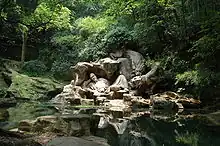
|
Common signs
|
- Do you have any rooms available?
- 你们有房间吗? (你們有房間嗎?) Nǐmen yǒu fángjiān ma?
- Does the room come with...
- 有没有... (有沒有...) Yǒu méiyǒu…
- ...bedsheets?
- ...床单? (...床單?) ...chuángdān?
- ...a bathroom?
- ...浴室? (浴室?) ...yùshì? (in China) / ...冲凉房? (...沖涼房?) ...chōngliángfáng? (in Singapore)
- ...a telephone?
- ...电话? (...電話?) ...diànhuà?
- ...a TV?
- ...电视机? (...電視機?) …diànshìjī?
- I will stay for _____ night(s).
- 我打算住_____晚。 (我打算住_____晚。) Wǒ dǎsuàn zhù _____ wǎn.
- Do you have a safe?
- 你们有没有保险箱? (你們有沒有保險箱?) Nǐmen yǒu méiyǒu bǎoxiǎn xiāng?
- Can you wake me at _____?
- 请明天早上_____叫醒我。 (請明天早上_____叫醒我。) Qǐng míngtiān zǎoshàng _____ jiàoxǐng wǒ.
- I want to check out.
- 我想退房。 (我想退房。) Wǒ xiǎng tuìfáng.
Money
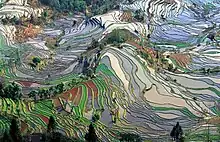
The base unit of currency in Chinese is the 元 (yuán), which could be translated as "dollar", or simply transliterated as "yuan", depending on what currency you are referring to. In financial contexts, such as when writing cheques and printing banknotes, 元 is written as 圆 (圓). One yuan is divided into 10 角 (jiǎo), which is in turn divided into 10 分 (fēn). Colloquially, the yuan is often referred to as the 块 (塊) (kuài), while the jiao is referred to as the 毛 (máo).
- pay
- 付 (付) fù
- cash
- 现金 (現金) xiàn jīn / 现钱 (現錢) xiàn qián
- credit card
- 信用卡 (信用卡) xìn yòng kǎ
- debit card
- 借记卡 (借記卡) jiè jì kǎ
- check
- 支票 (支票) zhīpiào
- foreign exchange
- 外汇 (外匯) wài huì
- to change money
- 换钱 (換錢) huàn qián
- exchange rate
- 汇率 (匯率) huìlǜ
- Chinese yuan
- 人民币 (人民幣) rénmínbì
- New Taiwan dollar
- 新台币 (新臺幣) xīn tái bì / 台币 (臺幣) tái bì
- Hong Kong dollar
- 港元 (港元) gǎng yuán / 港币 (港幣) gǎng bì
- Macau pataca
- 葡币 (葡幣) pú bì / 澳门元 (澳門元) ào mén yuán
- Singapore dollar
- 新加坡元 (新加坡元) xīnjiāpō yuán / 新币 (新幣) xīn bì
- Malaysian ringgit
- 马来西亚令吉 (馬來西亞令吉) mǎláixīyà lìngjí / 马币 (馬幣) mǎ bì
- US dollar
- 美元 (美元) mĕi yuán / 美金 (美金) mĕi jīn
- Euros
- 欧元 (歐元) ōu yuán
- British pounds
- 英镑 (英鎊) yīng bàng
Eating
|
Reading a Chinese Menu
Look for these characters to get an idea of what you're ordering. With help from The Eater's Guide to Chinese Characters (J. McCawley).
|
- Can I look at the menu, please?
- 请给我看看菜单。 (請給我看看菜單。) qǐng gěi wǒ kànkan càidān.
- Do you have an English menu?
- 你有没有英文菜单? (你有沒有英文菜單?) nǐ yŏu méi yǒu yīngwén càidān?
- (Listen for...
- Yes, we have one.
- 有(有) yǒu
- No, we don't.
- 没有 (沒有) méi yǒu
- Takeout / take away
- 打包 (打包) dǎ bāo / 外带 (外帶) wài dài'
- Eat here
- 这边吃 (這邊吃) zhèbiān chī / 内用 (內用) nèi yòng
- Dine in
- 堂吃 (堂吃) tángchī / 堂食 (堂食) tángshí
|
Are you Buddhist?
|
- I'm a vegetarian
- 我吃素 (我吃素) wǒ chī sù
- I only eat Halal food.
- 我只吃清真食品 (我只吃清真食品) wǒ zhǐ chī qīngzhēn shípǐn
- breakfast
- 早饭 (早飯) zǎofàn / 早餐 (早餐) zǎocān
- lunch
- 午饭 (午飯) wǔfàn / 中饭 (中飯) zhōngfàn / 午餐 (午餐) wǔcān
- supper
- 晚饭 (晚飯) wǎnfàn / 晚餐 (晚餐) wǎncān
- beef
- 牛肉 (牛肉) niúròu
- pork
- 猪肉 (豬肉) zhūròu,or sometimes simply 肉 (肉) ròu.
- mutton
- 羊肉 (羊肉) yángròu
- chicken
- 鸡肉 (雞肉) jīròu
- duck
- 鸭 (鴨) yā
- goose
- 鹅 (鵝) é
- fish
- 鱼 (魚) yú
- cheese
- 奶酪 (奶酪) nǎilào
- eggs
- 鸡蛋 (雞蛋) jīdàn / 蛋 (蛋) dàn (the former specifically refers to chicken eggs, the latter can be used generally for any type of egg)
- fresh
- 新鲜 (新鮮) xīnxiān
- fruit
- 水果 (水果) shuĭguǒ
- vegetables
- 蔬菜 (蔬菜) shūcài / 青菜 (青菜) qīngcài
- bread
- 面包 (麵包) miànbāo
- noodles
- 面条 (麵條) miàntiáo
- fried rice
- 炒饭 (炒飯) chǎofàn
- dumpling
- 饺子 (餃子) jiǎozi
- cooked rice
- 米饭 (米飯) mĭfàn (China) / 饭 (飯) fàn (Singapore)
- raw rice
- 米 (米) mĭ
- congee / rice porridge
- 粥 (粥) zhōu / 稀饭 (稀飯) xīfàn
- coffee
- 咖啡 (咖啡) kāfēi
- black coffee
- 黑咖啡 (黑咖啡) hēi kāfēi
- milk
- 奶 (奶) nǎi / 牛奶 (牛奶) niúnǎi (The former is more general, while the latter specifically refers to cow's milk.)
- butter
- 奶油 (奶油) nǎiyóu (in China and Taiwan) / 牛油 (牛油) niúyóu (in Singapore)
- sugar
- 糖 (糖) táng (Also means "candy".)
- salt
- 盐 (鹽) yán
- ground pepper
- 胡椒粉(胡椒粉)hújiāo fěn
- soy sauce
- 酱油 (醬油) jiàngyóu
- fish sauce
- 鱼露 (魚露) yúlù
- oyster sauce
- 蚝油 (蠔油) háoyóu
- tea (drink)
- 茶 (茶) chá
- green tea
- 绿茶 (綠茶) lǜ chá
- scented tea
- 花茶 (花茶) huāchá
- black tea
- 红茶 (紅茶) hóngchá
- juice
- 果汁 (果汁) guǒzhī
- water
- 水 (水) shuĭ
- natural mineral water
- 矿泉水 (礦泉水) kuàngquán shuǐ
- beer
- 啤酒 (啤酒) píjiŭ
- red/white wine
- 红/白 葡萄酒 (紅/白 葡萄酒) hóng/bái pútáojiŭ
- Excuse me, waiter? (getting attention of server)
- 服务员! (服務員!) fúwùyuán
In Taiwan and Singapore, it is common to call a waitress using the term 小姐 xiǎojiě, but this is a euphemism for "prostitute" in mainland China and would thus be highly offensive. - It was delicious.
- 很好吃。(很好吃。) hěn hǎochī (eating) / 很好喝。(很好喝。) hěn hǎohē (drinking)
- The check, please.
- 买单 (買單) mǎidān
Bars

- Do you serve alcohol?
- 卖不卖酒? (賣不賣酒?) mài búmài jiǔ?
- Is there table service?
- 有没有餐桌服务? (有沒有餐桌服務?) yǒu méiyǒu cānzhuō fúwù?
- A beer/two beers, please.
- 请给我一杯/两杯啤酒。 (請給我一杯/兩杯啤酒。) qǐng gěiwǒ yìbēi/liǎngbēi píjiǔ
- A glass of red/white wine, please.
- 请给我一杯红/白葡萄酒。 (請給我一杯紅/白葡萄酒。) qǐng gěi wǒ yìbēi hóng/bái pútáojiǔ
- A pint, please.
- 请给我一品脱。(請給我一品脫。) qǐng gěi wǒ yìpǐntuō
- A bottle, please.
- 请给我一瓶。 (請給我一瓶。) qǐng gěi wǒ yìpíng
- _____ (hard liquor) and _____ (mixer), please.
- 请给我_____和_____。 (請給我_____和_____。) qǐng gěi wǒ _____ hé _____
- baijiu (Chinese hard liquor)
- 白酒 (白酒) báijiǔ
- whiskey
- 威士忌 (威士忌) wēishìjì
- vodka
- 伏特加 (伏特加) fútèjiā
- rum
- 兰姆酒 (蘭姆酒) lánmǔjiǔ
- water
- 水 (水) shuǐ
- mineral spring (i.e. bottled) water
- 矿泉水 (礦泉水) kuàngquánshuǐ
- boiled water
- 开水 (開水) kāishuǐ
- club soda
- 苏打水 (蘇打水) sūdǎshuǐ
- tonic water
- 通宁水 (通寧水) tōngníngshuǐ
- orange juice
- 橙汁 (橙汁) chéngzhī
- Coke (soda)
- 可乐 (可樂) kělè
- Do you have any bar snacks?
- 有没有吧台点心? (有沒有吧臺點心?) yǒu méiyǒu bātái diǎnxīn?
- One more, please.
- 请再给我一个。 (請再給我一個。) qǐng zài gěi wǒ yíge
- Another round, please.
- 请再来一轮。 (請再來一輪。) qǐng zàilái yìlún
- When is closing time?
- 几点打烊/关门? (幾點打烊/關門?) jǐdiǎn dǎyáng/guānmén?
- Where is the toilet?
- 厕所在哪里? (廁所在那裏?) cèsuǒ zài nǎlǐ?
- Where is the washroom?
- 洗手间在哪里? (洗手間在哪裡?) xǐshǒujiān zài nǎlǐ?
- You're handsome.
- 你好帅。 (你好帥。) nǐ hǎo shuài
- You're pretty.
- 你好漂亮。 (你好漂亮。) nǐ hǎo piàoliang
Shopping
Bargaining (还价 (還價) huán jià) is possible (and expected) in markets and many small shops. The first price you are given will usually be hugely inflated - it's up to you to haggle it down to something more acceptable. This will probably feel awkward if you aren't used to it, and you may worry about ending up cheating the seller. Don't worry - sellers won't take a price that's too low, and you will usually end up agreeing on a price that's considerably lower than the starting one but still allows the seller to make a profit. Try starting at around 20-30% of the original price; you can always work up from there. The exceptions to the rule are supermarkets, large department stores, bookshops and some of the higher end boutiques, most of which will have signs letting you know that haggling is unacceptable in these stores.
- Do you have this in my size?
- 有没有我的尺码? (有沒有我的尺碼?) yǒu méiyǒu wǒde chǐmǎ?
- How much is this?
- 这个多少钱? (這個多少錢?) zhège duōshǎo qián?
- That's too expensive.
- 太贵了。 (太貴了。) tài guì le
- Would you take _____?
- _____元可以吗? (_____元可以嗎?) _____ yuán kěyǐ ma?
- expensive
- 贵 (貴) guì
- cheap
- 便宜 (便宜) piányi
- I can't afford it.
- 我带的钱不够。 (我帶的錢不夠。) wǒ dài de qián búgòu
- I don't want it.
- 我不要。 (我不要。) wǒ bú yào
- You're cheating me.
- 你欺骗我。 (你欺騙我。) nǐ qīpiàn wǒ Use with caution!
- I'm not interested.
- 我没有兴趣。 ( 我沒有興趣。) wǒ méiyǒu xìngqù
- OK, I'll take it.
- 我要买这个。 (我要買這個。) wǒ yào mǎi zhège
- Do you need a carrier-bag? / Yes / No
- 你要不要袋子? nǐ yào bu yào dàizi? / 要 yào / 不要 bú yào
- Please provide me with a carrier-bag.
- 请给我个袋子。 (請給我個袋子。) qǐng gěi wǒ ge dàizi
- Do you ship (overseas)?
- 可以邮寄到海外吗? (可以郵寄到海外嗎?) kěyǐ yóujì dào hǎiwài ma?
- I need...
- 我要_____ (我要_____) wǒ yào _____
- ...toothpaste.
- 牙膏 (牙膏) yágāo
- ...a toothbrush.
- 牙刷 (牙刷) yáshuā
- ...sanitary napkins.
- 卫生巾 (衛生巾) wèishēngjīn
- ...tampons.
- 卫生棉条 (衛生棉條) wèishēng miántiáo
- ...soap.
- 肥皂 (肥皂) féizào
- ...shampoo.
- 洗发精 (洗髮精) xǐfàjīng
- ...pain reliever. e.g., aspirin or ibuprofen
- 止疼药 (止疼藥) zhǐténg yào
- ...cold medicine.
- 感冒药 (感冒藥) gǎnmào yào
- ...stomach medicine.
- 胃肠药 (胃腸藥) wèicháng yào
- ...a razor.
- 剃须刀 (剃鬚刀) tìxūdāo
- ...an umbrella.
- 雨伞 (雨傘 ) yǔsǎn
- ...sunblock lotion.
- 防晒霜 (防晒霜) fángshàishuāng
- ...a postcard.
- 明信片 (明信片) míngxìnpiàn
- ...postage stamps.
- 邮票 (郵票) yóupiào
- ...batteries.
- 电池 (電池) diànchí
- ...writing paper.
- 纸 (紙) zhǐ
- ...a pen.
- 笔 (筆) bǐ
- ...a pencil.
- 铅笔 (鉛筆) qiānbǐ
- ...glasses.
- 眼镜 (眼鏡) yǎnjìng
- ...English-language books.
- 英文书 (英文書) Yīngwén shū
- ...English-language magazines.
- 英文杂志 (英文雜誌) Yīngwén zázhì
- ...an English-language newspaper.
- 英文报纸 (英文報紙) Yīngwén bàozhǐ
- ...a Chinese-English dictionary.
- 汉英词典 (漢英詞典) Hàn-Yīng cídiǎn
- ...an English-Chinese dictionary.
- 英汉词典 (英漢詞典) Yīng-Hàn cídiǎn
Driving
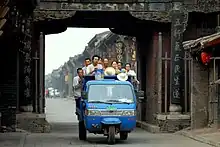
- I want to rent a car.
- 我想要租车。 (我想要租車。) wǒ xiǎngyào zūchē
- Can I get insurance?
- 我可以买保险吗? (我可以買保險嗎?) wǒ kěyǐ mǎi bǎoxiǎn ma?
- stop (on a street sign)
- 停 (停) tíng
- one way
- 单行道 (單行道 ) dānxíngdào
- yield
- 让路 (讓路) rànglù
- no parking
- 禁止停车 (禁止停車) jìnzhǐ tíngchē
- speed limit
- 速度限制 (速度限制) sùdù xiànzhì
- gas (petrol) station
- 加油站 (加油站) jiāyóuzhàn
- petrol
- 汽油 (汽油) qìyóu
- diesel
- 柴油 (柴油) cháiyóu
Authority

- I haven't done anything wrong.
- 我没有做错事。 (我沒有做錯事。) wǒ méiyǒu zuòcuò shì
- It was a misunderstanding.
- 这是误会。 (這是誤會。) zhè shì wùhuì
- Where are you taking me?
- 你带我去哪里? (你帶我去哪里?) nǐ dài wǒ qù nǎlǐ?
- Am I under arrest?
- 我被捕了吗? (我被捕了嗎?) wǒ bèibǔle ma?
- I am an American/Australian/British/Canadian citizen.
- 我是 美国/澳洲/英国/加拿大 公民。 (我是 美國/澳洲/英國/加拿大 公民。) wǒ shì měiguó/àozhōu/yīngguó/jiānádà gōngmín
- I want to talk to the American/Australian/British/Canadian embassy/consulate.
- 我希望跟 美国/澳洲/英国/加拿大 的 大使馆/领事馆 联系。 (我希望跟 美國/澳洲/英國/加拿大 的 大使館/領事館 聯繫。) wǒ xīwàng gēn měiguó/àozhōu/yīngguó/jiānádà de dàshǐguǎn/lǐngshìguǎn liánxì
- I want to talk to a lawyer.
- 我希望跟律师联系。 (我希望跟律師聯繫。) wǒ xīwàng gēn lǜshī liánxì
- Can I just pay a fine now?
- 我可以现在支付罚款吗? (我可以現在支付罰款嗎?) wǒ kěyǐ xiànzài zhīfù fákuǎn ma?
Telephone and the Internet
|
Telephone & Internet
In most Chinese cities, there are no telephone booths. Instead, small street shops have telephones which can usually be used for national calls. Look for signs like this:
Most cafes are cheaper than in hotels. Many mid-range hotels and chains now offer free wireless or plug-in internet. Those cafes are quite hidden sometimes and you should look for the following Chinese characters:
|
- mobile phone
- 手机 (手機) shǒujī (China and Taiwan) / 手提电话 (手提電話)shǒutí diànhuà (Singapore)
- Can I make international calls here?
- 可以打国际电话吗? (可以打國際電話嗎?) kěyǐ dǎ guójì diànhuà ma?
- How much is it to America/Australia/Britain/Canada?
- 打到 美国/澳洲/英国/加拿大 是多少钱? (打到 美國/澳洲/英國/加拿大 是多少錢?) dǎdào měiguó/àozhōu/yīngguó/jiānádà shì duōshǎo qián?
- Where can I find an Internet cafe?
- 哪里有网吧? (哪裏有網吧?) nǎlǐ yǒu wǎng bā?
- How much is it per hour?
- 一小时是多少钱? (一小時是多少錢?) yī xiǎoshí shì duōshǎo qián?
Getting a massage
- "Pain" and "no pain"
- 痛 tòng and 不痛 bú tòng
- "Good" and "not good"
- 好 hǎo and 不好 bù hǎo
- "Very good" or "great"
- 很好 hěn hǎo
- "Want" and "don't want"
- 要 yào and 不要 bú yào
- "That tickles"
- 痒 yǎng
- "Does this hurt?"
- 痛不痛? tòng bú tòng? or tòng ma?. For either, answer tòng or bú tòng.
Learning more
.jpg.webp)
Chinese language learning is flourishing as foreigners recognize the importance of gaining the ability to effectively communicate with a population of 1.3+ billion people. Due to the rapid rise of the Chinese teaching industry however, finding consistent quality instruction can be difficult. Many Chinese language schools and institutes have opened up over the past decade both abroad as well as within China, though before enrolling it is definitely recommended to thoroughly research and speak with current or former students to ensure that effective education is being provided.
For independent learners, it is imperative that one first master tones and the pinyin system before beginning to build vocabulary. The Hanyu Shuiping Kaoshi (HSK, 汉语水平考试) or Chinese Proficiency Test is China's standardized test for Chinese language proficiency (equivalent to the English TOEFL or IELTS). The HSK provides detailed guides for essential vocabulary and grammatical concepts in increasing level of fluency up to Level VI, which represents full written and oral abilities in the language. A good idea for practicing is to make Chinese friends online since millions of young people in China also look for somebody to practice English with. In Taiwan, the equivalent of the HSK is the Test of Chinese as a Foreign Language (TOCFL, 華語文能力測驗), though it is not as widely available or recognised internationally as the HSK.
- Chinese (Wikibooks.org): Free lessons providing detailed grammar explanations, audio samples and stroke order animations.
- Digital Dialects Chinese: Interactive games for learning Chinese in both Pinyin and simplified characters.
- Chinese Flashcards: Annotated Texts, Flashcards, Multiple choice tests
- Dear Dim Sum, daily small bites Chinese lessons
- Chinese Reading Practice: Annotated stories for learners at varying levels
English-Chinese and Chinese-English dictionaries are often disappointingly incomplete and have surprisingly many errors, at least once you get past the basics. Some decent digital dictionaries include:
- Pleco (possibly the most complete Chinese-English dictionary app aimed at learners)
- Youdao (有道词典, popular with Chinese students learning English)
- Wiktionary
The first two can be downloaded as apps, and Pleco can be used offline.
